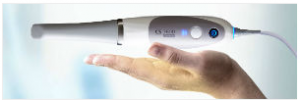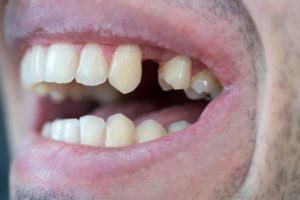Header logo
header top contact widget
Aesthetic Gum Treatment
Bad Breath? That May Be The Least Of Your Problems!
Posted on May 23, 2019 by William J. Claiborne, DDS MS
We’ve all run into people who have bad breath. Although a tuna salad lunch or onion-laden hot dog can cause folks to pull back from close-up conversations, these forms of bad breath are temporary.
 The smelly breath odor that is more concerning is that which comes from the sticky film of bacteria that coats the mouth and emits sulfuric odors (likened to rotten eggs). This film, known as plaque, coats the teeth and gums when allowed to build up.
The smelly breath odor that is more concerning is that which comes from the sticky film of bacteria that coats the mouth and emits sulfuric odors (likened to rotten eggs). This film, known as plaque, coats the teeth and gums when allowed to build up.
For example, the reason you wake up with not-so-fresh breath in the morning is the result of the mouth being closed all night while bacteria reproduces and accumulates. Without brushing and due to declined saliva flow (your mouth’s natural rinsing agent) during sleep, oral bacteria amass. Thus, you wake up with the sticky film and the breath that goes with it.
For those who are mouth-breathers during sleep or who snore, dry oral tissues allow for even more bacterial growth.
Once you brush and rinse thoroughly, however, you can expect your breath to become more pleasant. Persistent bad breath, however, may be the a side effect of medication, an illness, or periodontal (gum) disease.
As a periodontal specialist, I’m very much aware of the distinct odor produced by gum disease. Although it varies slightly from person to person, it has an offensive scent than that of typical bad breath.
The best way to determine gum disease as the true source is through a periodontal exam. In addition to persistent bad breath, periodontal disease symptoms include gum tenderness, gums that bleed when brushing, and gums that are red in color rather than a healthy pink. Early stage gum disease (gingivitis) may not cause any obvious symptoms, however.
Regardless of the source of unpleasant breath odor, it is imperative to have and maintain good oral health – for reasons that can impact your overall health. Through decades of research and studies, the bacteria of gum disease has been linked to serious health problems, including heart disease, stroke, arthritis, diabetes, impotency and some cancers.
For example, rheumatoid arthritis (RA) and pneumonia are just two diseases that have a connection to gum disease. Researchers have found that RA sufferers have a higher incidence of periodontal (gum) disease compared to individuals with a healthy oral condition.
Studies have also shown that RA patients are nearly 8 times more likely to have gum disease. Although insufficient oral hygiene can certainly be a determining factor in acquiring gum disease, other parameters point to a deeper association between RA and gum disease.
Because both RA and gum disease both cause internal inflammation, a connection between the two are most prevalent when examining the joints and oral tissues. Oral tissues with the presence of periodontitis compared to tissues of RA-affected joints show a number of similarities. Research has also discovered a genetic link between the two.
And the health threats go further. One study published by Science Daily found that the bacteria present in the mouth can release toxins that can make their way into the brain. (https://www.sciencedaily.com/releases/2019/01/190123165002.htm)
Once there, they may contribute to Alzheimer’s disease. While studies on this connection continue, other studies have found a clear path of triggers traced to the inflammatory reactions caused by the bacteria of gum disease.
Once periodontal disease is established in the mouth, its pathological byproducts can enter the bloodstream, lymph fluid, and bone structures. This can lead to the spread of infection and inflammation to all areas of the body. In this way, periodontal disease has been shown to be a cause of systemic disease.
While fresh breath and a gleaming smile are important, it’s clear that oral wellness plays a leading role in helping you avoid serious, and even deadly, health conditions.
If you’re experiencing any of the symptoms of gum disease mentioned above or are past due for a dental exam, call our Asheville periodontal office at 828-274-7440. If desired, you can begin with a private consultation, where we will discuss your symptoms and health history. During this time, I’ll answer your questions, explain treatment options and discuss comfort methods.
Asheville Periodontic Specialty Office Offers Latest To Enhance Treatment Outcomes, Comfort.
Posted on May 13, 2019 by William J. Claiborne, DDS MS
As an Asheville NC periodontist, I know it is more than my specialized skills that keep us busy. Many dentists and other dental specialists refer patients to our office because they know each patient receives optimal care with a gentle, respectful touch.
Another thing we are known for is the state-of-the-art technology we use to save patients time while they achieve the very best results in minimal treatment time. Some of our advanced features available include:
LANAP Protocol Using PerioLase MVP-7 – An acronym for Laser-Assisted New Attachment Procedure, LANAP provides an advanced protocol to more efficiently and effectively treat periodontitis (advanced gum disease) with the PerioLase® MVP-7™ laser. This offers a minimally invasive (non-surgical) treatment alternative for patients with moderate to severe periodontal disease.LANAP treatment leaves very little discomfort and has a quick recovery time. It has also been found to stimulate bone regrowth in damaged areas.
Dental Radiology With 3-D Cone Beam Technology – We rely on 3D imaging in diagnostic and treatment planning. This latest level of 3D imaging covers the whole dentition area, giving a clear view of the mandible and maxilla (upper and lower jaw) for intricate review for the diagnostic requirements of endodontics, periodontics, orthodontics, implantology, TMJ and prosthodontics as well as dental and maxillofacial surgery.
In addition to imaging, cone beam radiographs provide images in sagittal, axial, and coronal planes. This makes it possible to locate and trace the mandibular nerve canal for pre-surgical planning for an ideal implant position.
We also like that our patients are exposed to only minute levels of radiation through a process that is fast and comfortable.
CareStream Cone Beam Computer Tomography Imaging – Our office features the Carestream 9300. This Cone Beam Computer Tomography provides dual modality panoramic and 3D imaging with exceptional detail and range. The CS 9300 can deliver 3D imaging at a significantly lower dose than 2D panoramic imaging. In fact, in a recent study, the CS 9300 and CS 9300 had up to an 85% lower radiation dose than traditional panoramic imaging.

Carestream 3600
CS 3600 intraoral scanner – No longer do our patients have impressions made with bulky, goopy trays held in their mouths!
The CS 3600 Scanner is designed to quickly and comfortably scan areas inside our patient’s mouth. It acquires digital impressions accurately and easily, scanning a full or dual arch for the fabrication of digital models or appliances.
The CS 3600 provides a highly accurate digital impression using a small, handheld scanner. It can also reach difficult–to–access areas in the patient’s mouth for superior results with improved patient comfort.
Just some of the superior features of the CS 3600 Scanner include:
• Acquires digital impressions to design crowns, inlays, onlays, bridges, orthodontic appliances and aligners, custom abutments and RPD;
• Has an Intelligent Matching System that prevents missing data in any area. Plus, it even sends a warning to indicate areas of the scan that lack detail;
• Has adaptive hole filling that automatically identifies holes and selects the appropriate anatomical color for optimal aesthetic outcomes;
• Enhances outcomes for restorations, orthodontics and implants; and,
• Displays precise, accurate HD 3D color images with vivid color and details for improved case review, analysis and communication between doctors, referrals and labs.
Simplant Dental Software for Computerized Dental Implant Placement – This advanced software system allows for pre-surgical positioning of dental implants on the computer using a 3D model of the patient’s jaw. Once the implant type is selected, a surgical template is developed that ensures a precision fit. Simplant creates optimal implant treatment success, even for complex cases. It also simplifies the team treatment process so intricate aspects of the surgical process can be discussed prior to placement.
Intraoral Camera Technology – This self-contained intraoral camera features full motion video with outstanding image quality from an internal camera that captures ideal angles and images with the click of a button. The images are sent to screen for a clear, crisp view so we can confer with patients on specific treatment issues.
Computer Imaging In Treatment Suites – Treatment suites are equipped with computers for convenient image sharing with patients. This allows patients to have a more complete understanding of their individual needs through images that can be pulled up by our dental team, with the ability to enlarge certain areas to show specific details. Through this, patients have greater involvement in treatment decisions.
Advanced Sterilization – Our custom sterilization unit is designed to adhere to or exceed established Centers For Disease Control & Prevention (CDC) guidelines for instrument processing protocols. Intuitive colored lighting identifies the receiving and cleaning of instruments.
Fully-Equipped Surgical Suites – Relax during treatment (under sedation, if desired) while you are surrounded with the serene views surrounding our Asheville periodontal office.
So you see, we are committed to providing each patient with advanced skills, experience, comfort, and technology that provides the very best in periodontal and dental implant treatment available.
If you have experienced periodontal (gum) disease or are considering gum recontouring or tooth replacement with dental implants, being referred is not always needed. Call our friendly staff to discuss your needs: 828-274-9440.
Pregnant? Make Oral Health A Particular Priority!
Posted on Apr 23, 2019 by William J. Claiborne, DDS MS
With pregnancy, there seems to be a long list of do’s and don’ts for the mom-to-be. For instance, pregnant women are advised to avoid most drugs, alcohol, certain foods, and all smoking! Proper exercise, a balanced diet, and plenty of sleep help to keep both mother and baby healthy when it comes time for delivery.
Now, obstetricians are urging their pregnant patients (or those trying to become pregnant) to add a very important item to this list. They are advising particular devotion to achieving and maintaining good oral health.
The reason to keep a healthy mouth is based on decades of research and findings related to how infectious bacteria of periodontal (gum) disease can penetrate the bloodstream. Once bloodborne, the bacteria are able to activate inflammatory triggers elsewhere in the body.
A mother-to-be is especially vulnerable to gum disease due to hormonal changes during her pregnancy. Almost 50 percent develop pregnancy gingivitis, a mild form of gum disease that causes gums to become swollen, tender and bleed easily when brushing.
However, because of their susceptibility, the risk for full-blown gum disease is higher for pregnant females with nearly a third developing gum disease.
Research has shown that gum disease increases the risk for pre-term delivery (prior to 37 weeks) and babies of low birth weight (less than 5.5 lbs.). One study showed the preterm birth rate for females without gum disease to be approximately 11 percent compared to nearly 29 percent for pregnant women with moderate to severe periodontal disease.
It has also been shown that gum disease increases the likelihood for late-term miscarriage and pre-eclampsia. When oral bacteria reach placental membranes via the bloodstream, inflammatory reactions were found to trigger pre-eclampsia or early labor.
One study showed that pregnant women with higher blood levels of antibodies to oral bacteria also had higher incidences of preterm birth and babies of low birth weight. These elevated antibodies have been found in amniotic fluid and fetal cord blood samples of infants who were preterm or of low birth weight at birth.
When periodontal disease is present, however, successful treatment has shown to lower the risk of preterm births.
For all individuals, however, the bacteria of gum disease is coming to light as a major contributor to a number of serious health problems. It is the nation’s’ leading cause of adult tooth loss and has been linked to heart disease, stroke, some cancers, diabetes, arthritis, high blood pressure and impotency.
Once the infectious bacteria of gum disease enter the bloodstream (typically through tears in weakened gum tissues), it can trigger inflammatory reactions, many serious and some that can have deadly consequences.
It is important to know the signs and symptoms of gum disease. These include gums that bleed when brushing, frequent bad breath, swollen or tender gums, gums that pull away from the base of teeth, or gums that darken in color.
While any of these should prompt an individual to seek out periodontal treatment, pregnant women have a particular need to seek care. A periodontist has specialized training in the diagnosis and treatment of all levels of gum disease – in a way that is safe for pregnant women (as well as all patients).
If you have any of the symptoms mentioned above (whether pregnant or not), you are urged to schedule an appointment at your earliest convenience. Call 828-274-9440 to arrange an examination to begin.
For Dental Implants, Begin With A Specialist For Optimal Results.
Posted on Apr 10, 2019 by William J. Claiborne, DDS MS
If you are considering dental implants to replace teeth or an appliance (dentures or partials), having your treatment BEGIN WITH a Periodontist offers many advantages to achieving a successful, overall result.
 A periodontist is a dentist who specializes in the he placement of dental implants as well as the prevention, diagnosis, and treatment of periodontal disease. Periodontists are experts in the treatment of oral inflammation of the gum tissues, which make up much of the foundation for an implant.
A periodontist is a dentist who specializes in the he placement of dental implants as well as the prevention, diagnosis, and treatment of periodontal disease. Periodontists are experts in the treatment of oral inflammation of the gum tissues, which make up much of the foundation for an implant.
A periodontist is familiar with the latest techniques for diagnosing and treating periodontal disease and trained in performing cosmetic periodontal procedures. To specialize in periodontology, he or she must undergo an additional 11 years, on average, to complete the educational, clinical and specialty requirements after high school.
Essentially, a periodontist becomes a dentist and continues on in education and training to further expand his or her realm of knowledge and skills. While some general dentists offer dental implant diagnosis and placement in their dental office, having a specially-trained periodontist can help you enjoy an optimal outcome based on a unique understanding of the supporting gums, bones, and appropriate implant types and placement.
For example, a dentist who offers dental implant services may actually have completed a brief weekend course hosted by a particular implant system company. The dentist, while ‘taught’ to place the particular implant type, is essentially instructed in what the hosting company teaches as far as diagnosis and placement of their system alone.
Yet, every mouth is different. An implant designed by one company may not be appropriate for the number of implants you actually need, nor the bone structures you have, or the number of teeth being supported. There are a number of factors that must be taken into consideration for a successful result.
A periodontist uses specialized training that covers all types of implant systems to carefully select the type of implant that is most appropriate for unique needs. From this, a treatment plan will be developed for the number of implants needed and ideal positioning in regards to existing bone structures and surrounding gum tissues.
If finding the “cheapest” price for your implant is the priority in your decision, the involvement of a periodontist will probably not be less expensive than what you’ll find advertised online. You’ll find bargains that sound too good to be true (which often are).
However, your choice in dental implant treatment should factor in the risks of failure. Some people are unaware that dental implants can “fail.” While insufficient at-home care can be a contributing factor to the need for implant removal, an implant that is placed at an improper depth and angle, or one that is too big or small to support the attached restorations (replacement teeth) is also a cause.
As a Periodontist in Asheville, I’ve had to remove a number of implants that were poorly selected or placed over the years. I feel badly for these patients, knowing they have to go through the entire process again, and make the investment all over again. In our practice, we take every step to “do it right the first time” so implant selection and placement is the very best for each patient.
At Biltmore Periodontics, we offer oral sedation for added relaxation. We also have a Board Certified Anesthesiologist on our team. Dr. Brad Stone is a medical doctor providing sedation and anesthesia for optimal comfort and relaxation. Here, our patients know us for making comfort and safety high priorities. (https://www.biltmoreperiodontics.com/comprehensive-care-team/) IV sedation provides patients with a “twilight sleep” state with a quick recovery. Too, it typically erases all memory of the procedure afterwards.
It may be tempting to consider a “cheap” dental implant offer or a “one-stop clinic” for your treatment. However, your overall comfort and long-term success should be the guiding force in your decisions in tooth replacement.
Begin with a consultation appointment. Call 828-274-9440. During this time, we can discuss the implant type that may work best for you and the process involved. We will also be happy to address anticipated fees and payment options, if desired.
Dental implants, when properly chosen, placed, and cared for, are designed to last your lifetime. In the proper hands, your new smile will be an everyday joy, every day of your life!
Recent Posts
Categories
Archives
- September 2024
- August 2024
- July 2024
- June 2024
- May 2024
- April 2024
- March 2024
- February 2024
- January 2024
- December 2023
- November 2023
- October 2023
- September 2023
- August 2023
- July 2023
- June 2023
- May 2023
- April 2023
- March 2023
- February 2023
- January 2023
- December 2022
- November 2022
- October 2022
- September 2022
- August 2022
- July 2022
- June 2022
- May 2022
- April 2022
- March 2022
- February 2022
- January 2022
- December 2021
- November 2021
- October 2021
- September 2021
- August 2021
- July 2021
- June 2021
- May 2021
- April 2021
- March 2021
- February 2021
- January 2021
- December 2020
- November 2020
- October 2020
- September 2020
- August 2020
- July 2020
- June 2020
- May 2020
- April 2020
- March 2020
- February 2020
- January 2020
- December 2019
- November 2019
- October 2019
- September 2019
- August 2019
- July 2019
- June 2019
- May 2019
- April 2019
- March 2019
- February 2019
- January 2019
- December 2018
- November 2018
- October 2018
- September 2018
- August 2018
- July 2018
- June 2018
- May 2018
- April 2018
- March 2018
- February 2018
- January 2018
- December 2017
- November 2017
- October 2017
- September 2017
- August 2017
- July 2017
- June 2017
- May 2017
- April 2017
- March 2017
- February 2017
- January 2017
- December 2016
- November 2016
- October 2016
- September 2016
- August 2016
- July 2016
- June 2016
- May 2016
- April 2016
- March 2016
- February 2016
- January 2016
- December 2015
- November 2015
- October 2015
- September 2015
- August 2015
- July 2015
- June 2015
- May 2015
- April 2015
- March 2015
- February 2015
- January 2015
- December 2014
- November 2014
- October 2014
- September 2014
- August 2014
- July 2014
- June 2014
- May 2014
- April 2014
- March 2014
- February 2014
- January 2014
- December 2013
- November 2013
- October 2013
- September 2013
- August 2013
- July 2013
- June 2013
- May 2013
- April 2013
- March 2013
- February 2013
- January 2013
- December 2012
- November 2012
- October 2012
- September 2012
- August 2012
- July 2012
- June 2012


